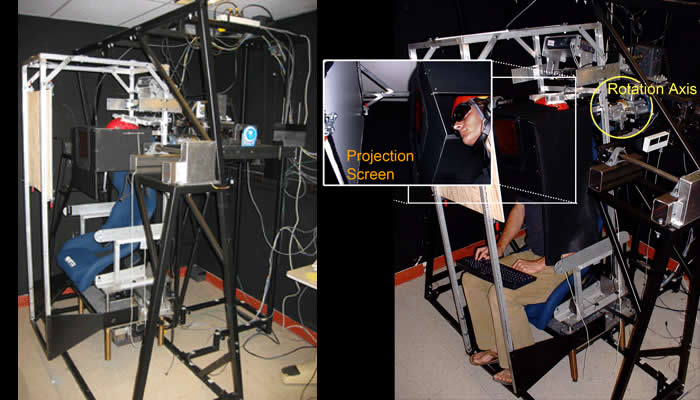![]()
The rotating chair and affixed stereo projection system allow manipulation of visual and vestibular cues to self-motion and body orientation. Visual cues to self-motion come from optic flow, the characteristic pattern of full-field motion generated on the retina when an observer moves relative to a stationary visual environment. Visual cues to body orientation come from objects of known orientation in world-coordinates, such as the horizon of an earth-horizontal ground plane. Vestibular cues to self-motion come from the semi-circular canals, which sense rotational accelerations, and from the otoliths, which sense linear accelerations. The otoliths also provide information about the direction of gravitational force, and thus body orientation. In our research, we measure perception based on visual cues, vestibular cues, and both simultaneously. By manipulating visual and vestibular cues independently in the rotating chair, we can determine how these sensory signals are integrated during perception, and what principles govern the sensory integration process.
The rotating chair was designed and constructed at Berkeley. The chair rotates smoothly up to ±22° about the roll, yaw, and pitch axes at a maximum velocity of 4 deg/s. Chair movements are driven by Baldor brushless servo motors, which are controlled by a Galil motion-controller board. Movements may be preprogrammed or controlled online via joystick or other input device. Encoders on the three axes monitor chair position for control purposes. To ensure movements are properly calibrated, chair orientation is also recorded by a Microstrain 3DM orientation sensor mounted just above the helmet.
The observer is seated in a contoured, padded, Sparco car-racing seat. The seat may be raised and lowered to position the head of the subject at the center of rotation of all three axes, which intersect at a point. The head is stabilized by an adjustable-size Petzl climbing helmet affixed to the chair.
The visual display is generated by a projector mounted above and behind the subject’s head. The projector is an NEC color DLP projector which has been modified by Fakespace Labs to render stereo images in grayscale with a frame rate of 60Hz per eye. The frame rate is synched with a pair of liquid crystal shutter glasses, such that different images may be rendered to the left and right eyes. The Cambridge Research System shutter lenses are mounted in safety goggles which may be worn comfortably over normal eyeglasses. This image is projected off a mirror and onto a Da-Lite projection screen mounted in front of the observer. Subjects view the image though a circular aperture which occludes unwanted frame cues. The circular field-of-view is approximately 50 degrees. Bose noise-cancellation headphones prevent subjects from hearing sounds associated with chair movement.
Our thanks to the Air Force Office of Scientific Research for their research support.
